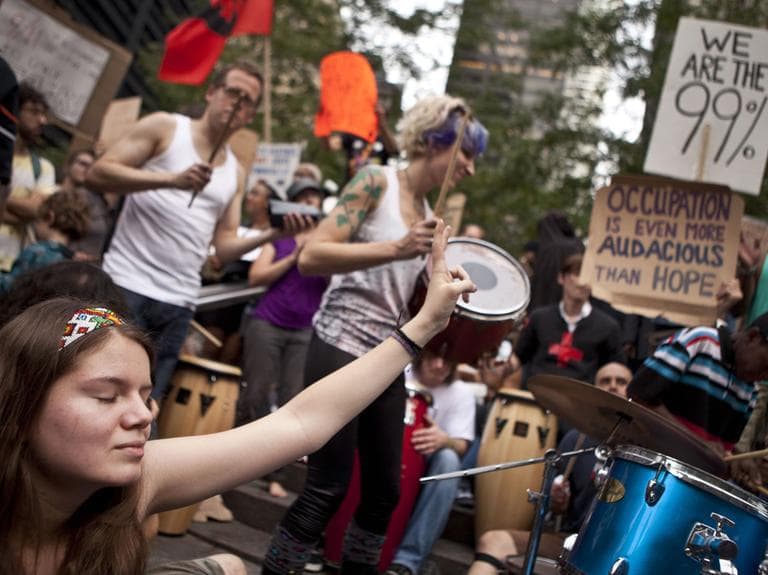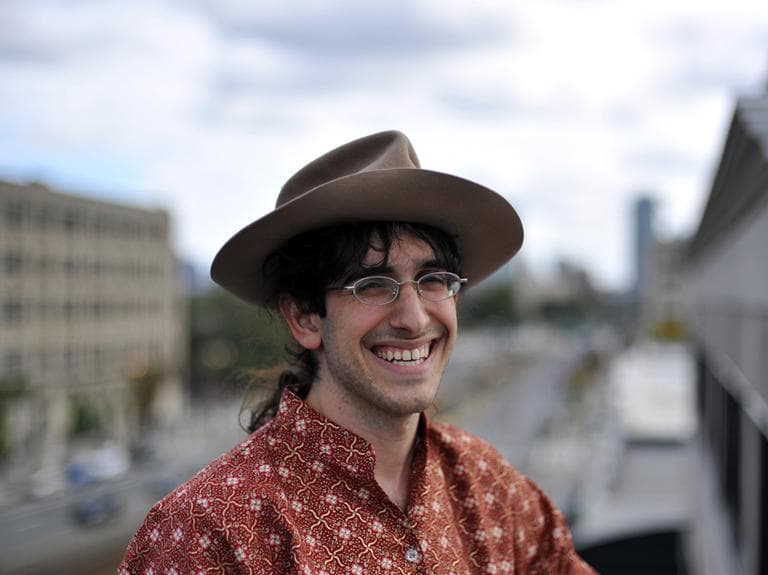Advertisement
Occupy Wall Street Examined
ResumeOccupy Wall Street has spread to cities and towns across the country. We’ll talk with some of the occupiers: what do they want? Where’s the movement headed?

The Occupy Wall Street movement first raised its flag – or flags – on September 17th in New York. Within two weeks it was world news. In three, it had the President and top politicians in both parties speaking to it. Not always respectfully.
Today, it’s reported active in 150 cities around the country and many more towns. It is sprawling. Proudly unregimented. But the top of its list of gripes is pretty clear. Gross inequality. Rampant joblessness and insecurity. The charge of a corrupted system. What now? We’ll ask.
This hour On Point: Occupy Wall Street is with us, in the studio.
-Tom Ashbrook
Guests
Bre Lembitz, an activist with Occupy Wall Street in New York.
Jon Phoenix, a student at Northeastern University, he has been active in the Occupy Boston protests.
Peter Kuhns, a community organizer for the Alliance of Californians for Community Empowerment, he has been active in the Occupy Los Angeles protests.
Todd Gitlin, a professor at the Columbia University Graduate School of Journalism.
Highlights
The Occupy Wall Street protests are sweeping the nation and stretching into their fourth week. It is getting national attention and raising questions about what exactly the demonstrators want and where their movement is headed.

“I felt like I was one in a million before joining this protest,” said Bre Lembitz, an activist with Occupy Wall Street in New York who has spent the past three weeks demonstrating in Lower Manhattan, and spending her nights in a sleeping bag. “The movement is giving voice to lots of other people who hold the same opinion as I do.”
Jon Phoenix, a student at Northeastern University and party of the Occupy Boston protests, said today that the motivation for the demonstrations are clear. “Society is too damned unfair,” he said “These tent cities you see out there are Obamavilles, they are the modern day equivalent of the Hoovervilles of the 1930s.”
Phoenix said that in the long run a third party could form as a result of the Occupy protests. “These protests at some point, they have to be translated into some type of tangible organization that can end up building something for the long term.”
And in Los Angeles, Peter Kuhns, a veteran community organizer active in the Occupy Los Angeles protests, said he sees people fighting for tangible results, like lower tuition and fewer foreclosures.
“What we’re seeing now is capitalism out of control – clearly,” Kuhns said. He said that there are numerous problems, including the high cost of college education, high numbers of foreclosures, and fair taxation. “One big question will be how our political leaders will respond to the demonstrations.”
Todd Gitlin, a professor at the Columbia University Graduate School of Journalism and a veteran of the radical student movement of the 1960s, had some advice for the demonstrators.
The most useful thing they could do, Gitlin said, was to act as a point of leverage on the Democratic Party. “By exercising a gravitational force there, it will remind intelligent Democrats that they [the protesters] can point the direction to victory,” Gitlin said.
More
You can find a collection of "We are the 99 percent" statements here.
From Tom's Reading List
The Nation "Six weeks later, on September 17, the occupation in downtown New York began, with scant attention, minimal and often derisive media coverage, and little expectation that it would light a spark where others had not. Now, in its fourth week, Occupy Wall Street has the quality of an exploding star: It is gathering energy in enormous and potent quantities, and propelling it outward to all corners of the country."
The New York Times "If some aspects of the Occupy Wall Street protest feel predictable — the drum circles, the signs, including “Tax Wall Street Transactions” and “End the FED” — so does the right-wing response. Is it any surprise that Fox News and its allied bloggers consider the protesters “deluded” and “dirty smelly hippies”? "
The Wall Street Journal "The Occupy Wall Street movement calls itself "leaderless," but a small cadre of dedicated activists has stepped up to manage the increasingly complex demonstrations as they move into their fourth week."
CNN "To be fair, the reason why some mainstream news journalists and many of the audiences they serve see the Occupy Wall Street protests as incoherent is because the press and the public are themselves. It is difficult to comprehend a 21st century movement from the perspective of the 20th century politics, media, and economics in which we are still steeped."
Playlist
Takin’ It To the Streets by The Doobie Brothers
This program aired on October 12, 2011.


